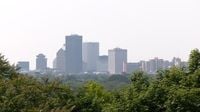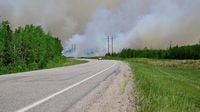For nearly a week, smoke from wildfires raging across Canada has drifted southward, blanketing large swaths of the northern United States in a hazy veil that has prompted multiple air quality alerts. From Minnesota to New York and Vermont, residents are grappling with the effects of this persistent smoke, which has pushed fine particulate levels into ranges considered unhealthy for sensitive groups.
In Minnesota, the Minnesota Pollution Control Agency (MPCA) issued an air quality alert covering the entire state starting at 11 p.m. on Saturday, June 7, 2025, and lasting until 11 p.m. Sunday night. The alert warns that fine particle levels will reach the orange air quality index (AQI) category, signaling unhealthy conditions for sensitive populations. These groups include people with asthma, heart disease, high blood pressure, diabetes, pregnant individuals, children, and older adults. The MPCA advises them to limit prolonged or heavy exertion and reduce time spent outdoors during this period.
Meanwhile, New York State is also experiencing significant air quality issues. The New York State Department of Environmental Conservation (NYSDEC) issued an air quality health advisory for fine particulates effective through midnight on Saturday, June 7, 2025, for much of the state. Areas affected include Western and Central New York counties such as Niagara, Erie, Monroe, Genesee, Ontario, Livingston, Cayuga, Onondaga, and cities including Buffalo, Rochester, Syracuse, and Canandaigua. Northern New York counties like St. Lawrence, Franklin, Clinton, Essex, Jefferson, and Lewis, including Plattsburgh, Watertown, and Lake Placid, are also impacted. The advisory extends to Southern Tier and Central New York counties such as Broome, Tioga, Cortland, Otsego, and Oneida, covering cities like Binghamton, Elmira, and Utica.
The NYSDEC warns that outdoor air quality levels are expected to exceed an AQI value of 100 for fine particulate matter (PM2.5), categorized as "Unhealthy for Sensitive Groups." State health officials recommend that individuals—especially young children, older adults, and those with asthma or heart and lung conditions—limit strenuous outdoor activities. Those experiencing symptoms related to poor air quality are urged to contact their healthcare providers.
Tracking tools are available for residents wanting to monitor air quality in real time, including the NYSDEC Air Quality Index website and the national fire.airnow.gov site.
Adding to the regional impact, an air quality health advisory was also in effect on Sunday, June 8, 2025, for the entire GLOW region in New York—covering Genesee, Livingston, Orleans, and Wyoming counties—and other parts of the state. This marked the third consecutive day an advisory was issued for the area and the fourth since June 4. The advisory extended to Niagara, northern and southern Erie, Chautauqua, Cattaraugus, Allegany, Monroe, Ontario, Wayne, northern Cayuga, Oswego, Jefferson, and Lewis counties.
Experts explain that the smoke originates from wildfires burning in the Canadian provinces of Alberta, Saskatchewan, and Manitoba. These fires have forced more than 25,000 people to evacuate and led to a state of emergency declaration in Manitoba last week. Since June 3, smoke has been drifting into Upstate New York, creating hazy skies and vivid sunsets, but also raising health concerns.
Fine particulate matter consists of tiny solid particles or liquid droplets in the air that are 2.5 micrometers or less in diameter (PM2.5). Exposure to elevated levels can cause short-term health effects such as irritation to the eyes, nose, and throat; coughing; sneezing; runny nose; and shortness of breath. For individuals with asthma or heart disease, these particles can exacerbate symptoms and lead to more serious complications.
In Vermont, the situation is similar. Hazy and smoky skies have pushed the Air Quality Index into unhealthy territory for sensitive groups across all counties. The New York Department of Health and the Department of Environmental Conservation have issued air quality health advisories covering the Adirondacks, Eastern Lake Ontario, and Central and Western New York, which border Vermont. On Saturday, June 7, 2025, views of landmarks such as Jay Peak, Camel’s Hump, and Mount Washington were obscured by smoke from Alburg Springs and the Alburgh Dunes State Park.
Residents expressed mixed feelings about the haze. Darlyne Mceleney of Stowe remarked, “It looks like a real hazy day. That’s what we thought it was at first, but it is the smoke from Canada. We have had so much rain, we are hoping to see the sun. But it is better today than if it were rainy.”
In Rochester, New York, smoke from Canadian wildfires has similarly caused hazy skies and degraded air quality. Dr. Daniel Croft, a pulmonology professor at the University of Rochester Medical Center (URMC), highlighted the groups most at risk: “Individuals who have asthma, COPD, or heart conditions, or individuals at the extremes of age: the young and old, and individuals who are pregnant. These are some populations that should take special care when the air pollution and the air quality worsen.”
Dr. Croft also noted that even healthy adults may experience lung inflammation due to air pollution, although symptoms like scratchy throat or wheezing might not be noticeable. “Even with normal lungs, it puts some degree of inflammation in the lungs. And it’s something that we’d like to try to avoid,” he said.
Despite the warnings, some local residents at Cobb’s Hill Park seemed relatively unbothered by the haze on Saturday, June 7. Robert Eden, a regular walker, recalled heavier smoke in previous years: “A couple of years ago it was heavy, very heavy. You could really feel it. I mean, in the eyes and in the nose. But that was like 2 or 3 years ago. Other than that, I’ve never been bothered by it.” Devin Miller, a parent and asthmatic, shared, “We feel good. I feel good. I’m an asthmatic myself, so I don’t have any issues or complications. She [my daughter] seems to be having the time of her life running around.”
Dr. Croft advised that anyone experiencing chest pain or cardiac issues during periods of high AQI should seek medical attention promptly. Residents can check current AQI levels for their location by visiting AirNow.gov.
As wildfires continue to burn in Canada, the resulting smoke and poor air quality are expected to persist for the near future, affecting millions across the northern United States. Health officials urge vigilance and caution, especially for vulnerable populations, while residents keep watch on the skies and their local air quality readings.



